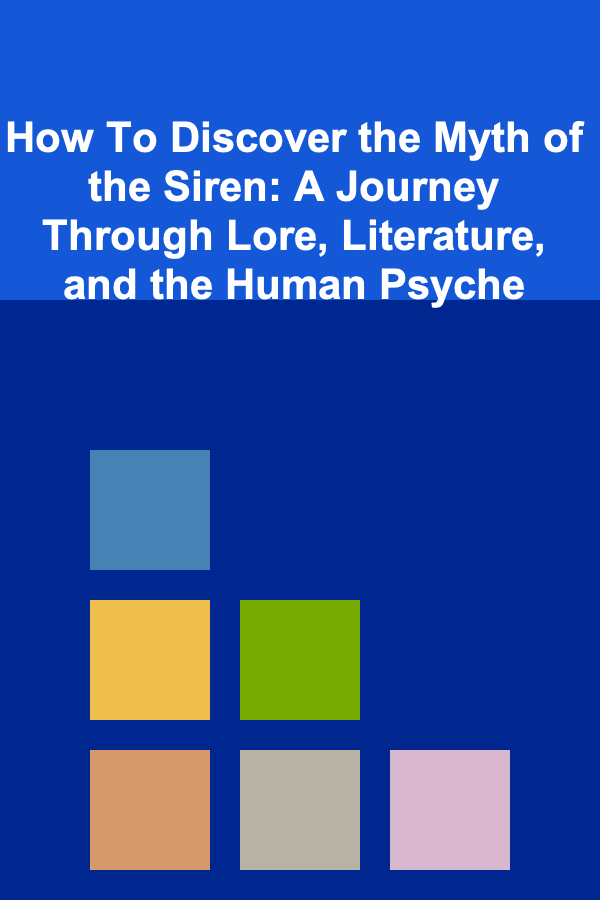
How To Discover the Myth of the Siren: A Journey Through Lore, Literature, and the Human Psyche
ebook include PDF & Audio bundle (Micro Guide)
$12.99$6.99
Limited Time Offer! Order within the next:

The myth of the Siren, a creature whose song lured sailors to their doom, is far more than a simple seafaring tale. It's a deeply layered narrative that reflects profound anxieties about desire, temptation, and the power of art itself. To truly discover the myth of the Siren requires a journey through ancient texts, artistic interpretations, and a critical examination of its enduring relevance to the human condition. This exploration isn't about finding a definitive answer, but rather about unraveling the complexities that make the Siren such a potent and lasting figure in the cultural imagination.
I. Unveiling the Siren in Ancient Literature: Homer's Odyssey and Beyond
Our primary source for understanding the Siren in ancient literature is, without a doubt, Homer's Odyssey . While the Odyssey isn't the sole source, it provides the most detailed and influential depiction. Here, the Sirens are not described physically -- only their deadly song is given prominence. Odysseus, warned by Circe, instructs his crew to plug their ears with beeswax and has himself tied to the mast. This allows him to hear the Sirens' song without succumbing to its lethal allure. This scene is laden with symbolic weight, offering insights into the ancient Greek understanding of the Siren myth.
Several key aspects of the Odyssey portrayal warrant closer examination:
- The Allure of Forbidden Knowledge: The Sirens promise Odysseus knowledge of the future and the past, proclaiming, "We know all the toils that the Argives and Trojans once endured on the broad plains of Troy, and we know all things that come to pass on the fruitful earth." This promise of omniscience is a powerful temptation, appealing to Odysseus' inherent curiosity and thirst for understanding. The Sirens, in essence, offer a shortcut to wisdom, bypassing the arduous process of learning through experience.
- The Power of Song: The Sirens' power resides almost entirely in their voice. It's the sound, not their appearance (which is left to the imagination), that is the primary weapon. This emphasizes the captivating and potentially dangerous power of art, specifically music and poetry. The Greeks, deeply valuing these art forms, were also aware of their potential to manipulate emotions and incite reckless behavior.
- The Struggle for Self-Control: Odysseus' clever strategy of plugging his crew's ears and tying himself to the mast highlights the importance of self-control and reason in overcoming temptation. He understands his own susceptibility to the Sirens' song and takes preemptive measures to protect himself. This is a key theme throughout the Odyssey -- the triumph of human intellect over instinct and impulse. However, it's crucial to note that Odysseus does want to hear the song. He actively seeks the experience, demonstrating a willingness to confront temptation, albeit in a controlled and ultimately safe manner. This adds a layer of complexity: is he truly resistant, or simply strategically indulging his curiosity?
- The Nature of Destruction: The Sirens don't physically attack the sailors. Instead, they lure them to their deaths by promising them something they crave -- knowledge, peace, fulfillment -- leading them to crash their ships against the rocks surrounding the Sirens' island. This subtly suggests that the real danger lies within the sailors themselves -- their own desires and vulnerabilities. The Sirens merely act as catalysts, exploiting pre-existing weaknesses.
While Homer provides the most detailed account, other ancient sources offer glimpses into variations of the Siren myth. Some accounts depict the Sirens as originally being handmaidens of Persephone, transformed into creatures with bird-like bodies after failing to prevent her abduction by Hades. This version connects the Sirens to the underworld and themes of loss and mourning. Other sources describe them as daughters of the river god Achelous and a Muse, further linking them to artistic inspiration and the power of water. These variations, while less prominent than the Homeric version, contribute to a richer understanding of the Siren myth's origins and evolution.
II. The Siren's Transformation: From Monstrous to Alluring in Art and Literature
The depiction of the Siren has undergone a significant transformation throughout history. In early Greek art, Sirens were often depicted as bird-women -- creatures with the body of a bird and the head of a woman. This monstrous image reflects their perceived danger and their association with the wild, untamed aspects of nature. Over time, however, the Siren's image gradually shifted towards a more alluring and seductive figure. By the Roman era, depictions of Sirens as beautiful women with fish tails, essentially mermaids, became increasingly common.
This shift in visual representation is mirrored in literature as well. While the early depictions emphasize the Siren's deadly nature and monstrous appearance, later adaptations often focus on their beauty and the tragic consequences of their existence. The Siren becomes a figure of both temptation and pathos, a creature cursed to use her beauty and voice to lure men to their deaths.
Consider these examples:
- Medieval Bestiaries: Medieval bestiaries, collections of descriptions and illustrations of animals both real and fantastical, often included Sirens. These depictions typically retained the bird-woman form, emphasizing their monstrous nature and association with sin and temptation. They served as allegorical warnings against succumbing to worldly pleasures.
- Renaissance Art: The Renaissance witnessed a renewed interest in classical mythology, and the Siren was frequently depicted in paintings and sculptures. Artists often emphasized their beauty and sensuality, portraying them as alluring women with flowing hair and seductive poses. This shift reflects the Renaissance's emphasis on humanism and the appreciation of beauty in all its forms.
- 19th-Century Literature and Art: The 19th century, with its Romantic and Symbolist movements, saw a resurgence of interest in the Siren myth. Artists and writers explored the psychological and emotional complexities of the Siren, often portraying her as a femme fatale -- a dangerous and seductive woman who leads men to their ruin. Think of John William Waterhouse's paintings, such as "Ulysses and the Sirens," which depict beautiful, almost ethereal women surrounding Odysseus, emphasizing their seductive power.
The transformation of the Siren from a monstrous bird-woman to a beautiful mermaid reflects evolving cultural attitudes towards women, sexuality, and the nature of temptation. The Siren becomes a canvas upon which society projects its anxieties and desires.
III. Deconstructing the Siren Song: Temptation, Desire, and the Power of Art
The Siren's power lies not just in her beauty, but in her song. To truly discover the myth of the Siren, we must deconstruct the nature of this song and its profound impact on the listener. What makes the Siren song so irresistible? What desires and vulnerabilities does it exploit?
Several interpretations are possible:
- The Song of Unfulfilled Desire: The Siren's song often promises the listener what they most desperately crave -- be it knowledge, power, love, or peace. It taps into their deepest longings and offers a fleeting glimpse of a utopian future. This resonates with the human tendency to idealize and romanticize the object of desire, blinding us to the potential dangers.
- The Song of the Past: As the Odyssey suggests, the Sirens offer knowledge of the past. This can be interpreted as a temptation to dwell on past glories or traumas, hindering our ability to move forward. The siren song becomes a form of nostalgic paralysis, trapping us in a cycle of regret and longing.
- The Song of the Self: Perhaps the Siren's song is not a specific promise, but rather a reflection of the listener's own inner voice, amplified and distorted. It's a seductive echo of their own desires and anxieties, confirming their deepest beliefs and validating their choices, even if those choices lead to destruction. This interpretation places the responsibility squarely on the individual, suggesting that the Siren's power is ultimately self-generated.
- The Song of Art and Illusion: The Siren's song can be seen as a metaphor for the power of art to captivate and transport us to another realm. Art, like the Siren's song, can be both beautiful and dangerous, offering us glimpses of truth and beauty while simultaneously distracting us from the realities of life. The danger lies in becoming so engrossed in the artistic illusion that we lose sight of the real world and its consequences.
It's important to recognize that these interpretations are not mutually exclusive. The Siren's song likely operates on multiple levels, simultaneously appealing to our desires, anxieties, and our appreciation for beauty. Its power lies in its ability to resonate with the individual on a deeply personal level, exploiting their unique vulnerabilities.
IV. The Siren in Modern Culture: Enduring Relevance and Contemporary Interpretations
Despite its ancient origins, the myth of the Siren continues to resonate in modern culture. From literature and film to music and advertising, the Siren figure remains a potent symbol of temptation, desire, and the power of illusion. Exploring these contemporary interpretations allows us to understand the enduring relevance of the Siren myth and its ability to adapt to changing cultural contexts.
Consider these examples:
- Literature: Numerous novels and short stories have reimagined the Siren myth, often focusing on the Siren's perspective and exploring her motivations and inner life. These works often challenge traditional interpretations of the Siren as a purely malevolent figure, portraying her as a victim of circumstance or a complex character with her own desires and vulnerabilities. Margaret Atwood's poem "Siren Song" is a classic example of this, giving the Siren a voice and revealing the boredom and loneliness behind her deadly allure.
- Film: Films such as "Splash" and "Pirates of the Caribbean: On Stranger Tides" feature mermaid-like creatures with seductive powers, echoing the Siren myth. These films often explore themes of love, sacrifice, and the conflict between the human world and the natural world. In some cases, the Siren is portrayed as a sympathetic figure, highlighting the dangers of human greed and exploitation.
- Music: Many musicians have drawn inspiration from the Siren myth, creating songs that explore themes of temptation, desire, and the dangers of illusion. Songs like "The Killing Moon" by Echo & the Bunnymen and "Siren Song" by Bat for Lashes evoke the ethereal and seductive qualities associated with the Siren's voice.
- Advertising: Advertisers often use the imagery and symbolism associated with the Siren myth to promote products and services. A perfume ad might feature a beautiful woman with flowing hair and a mesmerizing gaze, suggesting that the product will enhance the wearer's allure and make her irresistible. This taps into the ancient association between the Siren and the power of seduction. Even Starbucks, with its iconic mermaid logo, subtly utilizes the allure and mystery associated with the Siren figure.
The enduring appeal of the Siren myth lies in its ability to capture the timeless human struggle with temptation, desire, and the allure of the unknown. In a world saturated with images and information, the Siren serves as a reminder of the importance of critical thinking, self-control, and the ability to distinguish between reality and illusion.
V. The Siren Within: Recognizing Our Own Susceptibilities
Ultimately, discovering the myth of the Siren is not just about understanding ancient literature or artistic interpretations. It's about recognizing the Siren within ourselves -- the internal voices and desires that can lead us astray. We all have our own "Siren songs" -- temptations and illusions that threaten to derail us from our goals and values. These can take many forms: the allure of instant gratification, the seductive promise of easy success, the comforting embrace of denial, the validation of social media, or the pursuit of unattainable perfection.
To resist the allure of these internal Sirens, we must cultivate self-awareness, critical thinking, and a strong sense of our own values. This requires:
- Identifying our vulnerabilities: What are our weaknesses? What are we most likely to be tempted by? Understanding our own vulnerabilities is the first step in protecting ourselves from the Siren's song.
- Developing critical thinking skills: We must learn to question assumptions, evaluate evidence, and resist the urge to accept information at face value. This is particularly important in a world saturated with misinformation and propaganda.
- Cultivating mindfulness: Mindfulness practices, such as meditation, can help us become more aware of our thoughts and emotions, allowing us to recognize when we are being tempted by a Siren song.
- Surrounding ourselves with supportive relationships: Having strong relationships with trusted friends and family can provide us with the support and encouragement we need to resist temptation.
- Defining our values: Having a clear sense of our own values and priorities can help us make decisions that are aligned with our long-term goals, rather than succumbing to the fleeting allure of the Siren's song.
By recognizing our own internal Sirens and developing the skills to resist their allure, we can navigate the complexities of modern life with greater wisdom and resilience. The myth of the Siren, therefore, is not just a cautionary tale, but a call to self-awareness and personal responsibility.
VI. Conclusion: The Enduring Echo of the Siren's Song
The journey to discover the myth of the Siren is an ongoing process, a constant negotiation between the allure of temptation and the pursuit of truth. It's a journey that takes us through ancient texts, artistic interpretations, and a critical examination of our own inner landscape. The Siren, in her many forms, serves as a powerful reminder of the seductive power of illusion and the importance of self-awareness in navigating the complexities of life.
The Siren's song, though potentially destructive, is not inherently evil. It represents the very essence of desire, the yearning for something beyond our grasp. It is the unquestioning surrender to this desire, the abdication of reason and self-control, that leads to disaster. To truly discover the myth of the Siren is to learn to listen to the song without succumbing to its destructive allure. It is to acknowledge the power of art, desire, and temptation while maintaining a clear-eyed perspective and a firm grip on our own values. And in that balance, we find the true meaning of the Siren's enduring legacy.

How to Build Raised Garden Beds for Better Organization
Read More
How to Incorporate Indoor Plants for a Lively, Inviting Space
Read More
How to Make Your Home Security System More Reliable
Read More
Make Money from Deep Learning by Creating AI-based Online Courses
Read More
How to Integrate Reptile Enrichment into Your Care Routine
Read More
10 Tips for Growing Orchids Indoors for Beginners
Read MoreOther Products

How to Build Raised Garden Beds for Better Organization
Read More
How to Incorporate Indoor Plants for a Lively, Inviting Space
Read More
How to Make Your Home Security System More Reliable
Read More
Make Money from Deep Learning by Creating AI-based Online Courses
Read More
How to Integrate Reptile Enrichment into Your Care Routine
Read More